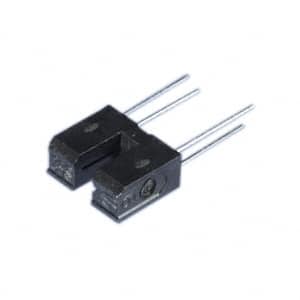Vedi le specifiche per i dettagli del prodotto.

GP1S52VJ000F
Introduction
The GP1S52VJ000F is a photo interrupter sensor that belongs to the category of optoelectronic devices. This device is commonly used for detecting the presence or absence of an object, and it is characterized by its compact package, high sensitivity, and reliable performance.
Basic Information Overview
- Category: Optoelectronic Device
- Use: Object Detection
- Characteristics: Compact, High Sensitivity, Reliable Performance
- Package: Through-Hole
- Essence: Photo Interrupter Sensor
- Packaging/Quantity: Bulk Packaging
Specifications
- Emitter Type: Infrared LED
- Detector Type: Phototransistor
- Operating Wavelength: 950nm
- Supply Voltage: 5V
- Output Configuration: Phototransistor Open Collector
- Operating Temperature Range: -25°C to 85°C
Detailed Pin Configuration
- VCC (Supply Voltage)
- GND (Ground)
- Output
Functional Features
- High Sensitivity to Infrared Light
- Fast Response Time
- Low Power Consumption
Advantages and Disadvantages
Advantages: - Compact Size - Reliable Performance - Low Power Consumption
Disadvantages: - Limited Operating Temperature Range - Susceptible to Ambient Light Interference
Working Principles
The GP1S52VJ000F operates based on the interruption of the infrared light beam between the emitter and detector. When an object obstructs the light path, the phototransistor output switches, indicating the presence of the object.
Detailed Application Field Plans
- Object Detection in Printers and Copiers
- Paper Jam Detection in Office Equipment
- Position Sensing in Automated Machinery
Detailed and Complete Alternative Models
- GP1S53VJ000F
- Similar specifications with enhanced ambient light immunity
- GP1S54VJ000F
- Higher sensitivity and wider operating temperature range
In conclusion, the GP1S52VJ000F photo interrupter sensor offers reliable object detection capabilities in a compact package, making it suitable for various industrial and consumer applications.
Word Count: 309
10 domande e risposte comuni relative all'applicazione di GP1S52VJ000F nelle soluzioni tecniche
What is GP1S52VJ000F?
- GP1S52VJ000F is a reflective photointerrupter sensor module that consists of an infrared emitting diode and a phototransistor.
What are the typical applications of GP1S52VJ000F?
- GP1S52VJ000F is commonly used in printers, copiers, vending machines, paper detectors, and other devices that require object detection or position sensing.
How does GP1S52VJ000F work?
- The infrared light emitted by the diode is reflected off an object and detected by the phototransistor, which then produces an output signal based on the presence or absence of the reflected light.
What is the operating voltage range of GP1S52VJ000F?
- The operating voltage range of GP1S52VJ000F is typically between 4.5V and 16V.
What is the typical output type of GP1S52VJ000F?
- The typical output type of GP1S52VJ000F is digital, providing a high or low signal based on the presence or absence of the reflected infrared light.
What is the sensing distance of GP1S52VJ000F?
- The sensing distance of GP1S52VJ000F is typically around 0.5mm to 2.5mm, depending on the specific application and setup.
Can GP1S52VJ000F be used for speed sensing?
- Yes, GP1S52VJ000F can be used for speed sensing in applications such as motor speed control or rotational speed detection.
Is GP1S52VJ000F sensitive to ambient light?
- GP1S52VJ000F has built-in ambient light rejection, making it less sensitive to ambient light interference.
What are the key advantages of using GP1S52VJ000F in technical solutions?
- Some key advantages include its compact size, high reliability, and ease of integration into various electronic systems.
Are there any precautions to consider when using GP1S52VJ000F?
- It's important to shield GP1S52VJ000F from direct sunlight or other strong light sources to prevent false readings, and to ensure proper alignment for accurate detection.

